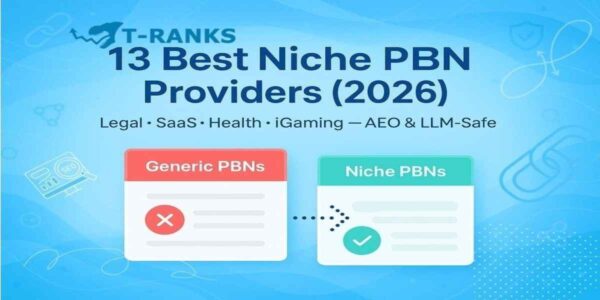Generic PBN links no longer deliver consistent results. As Google’s AI systems like Gemini and SpamBrain evaluate backlinks through context and meaning, networks that rely on mixed topics lose strength fast. Rankings drop not because of fewer links but because those links fail to match search intent and topic relevance.
Most PBNs still combine unrelated niches in one network. A SaaS backlink placed next to a casino review or lifestyle post sends conflicting signals that large language models can easily detect. Instead of building authority, these links confuse algorithms designed to read entity relationships across the web.
Niche-specific PBNs solve this problem by aligning every link with the site’s core topic. In 2026, relevance and semantic precision matter more than ever. Networks tailored to industries such as Legal, SaaS, Health, or iGaming reinforce entity trust, maintain schema consistency, and deliver safer, longer-lasting link equity.
This guide ranks the 13 best niche PBN providers that perform under AI-evaluated search systems. Each vendor was tested using the Koray Tuğberk Gübür PPR Matrix Prominence, Popularity, and Relevance—to measure index stability, topical depth, and real-world performance. By the end, you’ll know which networks pass link juice safely, support AI visibility, and help you build authority that last.
Why Niche-Relevant PBNs Outperform Generic Networks in 2026
A niche-relevant backlink is a link built from a website whose content and audience match your own industry. If a SaaS company earns backlinks from blogs discussing cloud tools, automation, or software reviews, that link is contextually aligned. Google’s AI systems see this as an organic connection between related entities. But if the same SaaS link appears on an unrelated food or travel site, it loses topical trust and ranking value.
Generic PBN networks may still transfer raw link juice, yet they rarely build entity-level confidence , a key ranking signal in AI Overviews and large language models (LLMs). In 2026, this alignment between topic, intent, and entity graph is what separates safe, long-lasting backlinks from high-risk footprints.
Why Niche Relevance Matters More Than Ever
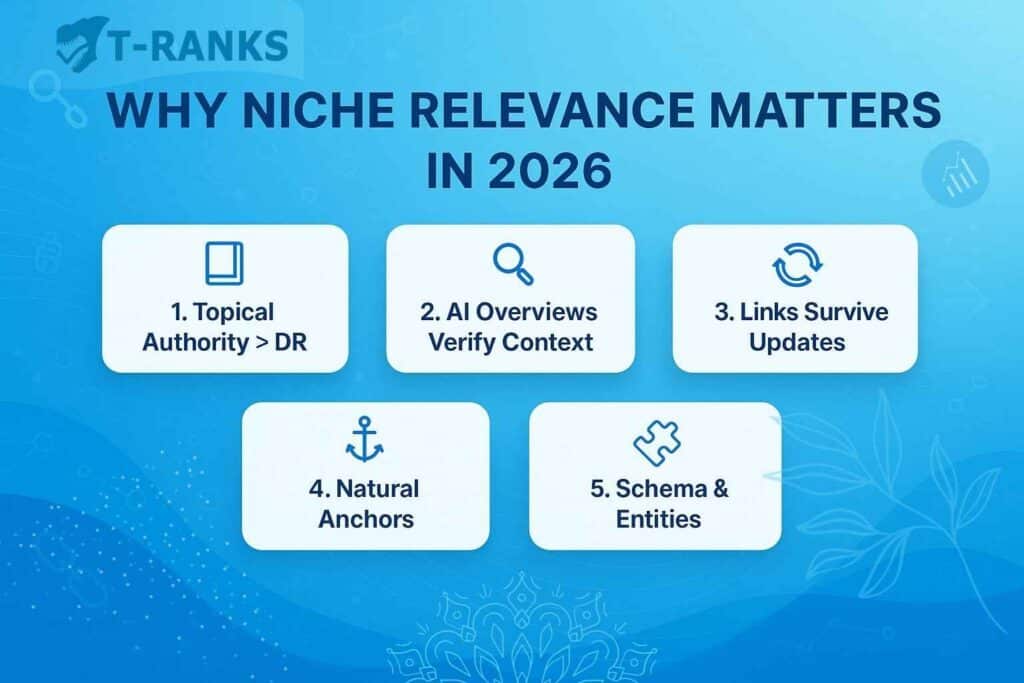
1. Topical authority now outweighs Domain Rating (DR)
Google’s current algorithms and Gemini’s LLM systems evaluate semantic connections rather than surface metrics. A health PBN linking to a fitness supplement site reinforces expertise within the same entity group. But a health site linking to a gaming portal looks inconsistent and can dilute authority signals.
2. AI Overviews cross-check context before surfacing pages
When AI systems verify citations, they analyze schema, anchor phrases, and co-occurring entities. Repeated mentions from topic-aligned sites make your domain easier to include in search summaries and AI Overview panels. That’s why niche-focused PBNs help websites appear more frequently in AI-generated snippets.
3. Niche backlinks sustain link equity through algorithm updates
Topically consistent PBN links behave like editorial mentions rather than paid placements. They survive core updates such as SpamBrain or the March 2025 link-spam refinement, which devalue manipulative cross-topic links. The safer your context, the longer your rankings hold.
4. Natural anchor text integration
In a niche context, anchors like cloud security software or legal case management tools blend naturally with surrounding text. When used on unrelated pages, those same phrases look artificial and can trigger filters. Using balanced, descriptive anchors (as detailed in anchor text optimization) strengthens relevance without risking over-optimization.
5. Reinforced schema and entity relationships
When backlinks originate from websites using matching schema—such as Product, Organization, or MedicalWebPage, Google recognizes consistent semantic patterns. Over time, this strengthens your knowledge graph connection and improves brand understanding for LLM-based ranking systems.
The PPR Framework Behind Strong Niche PBNs
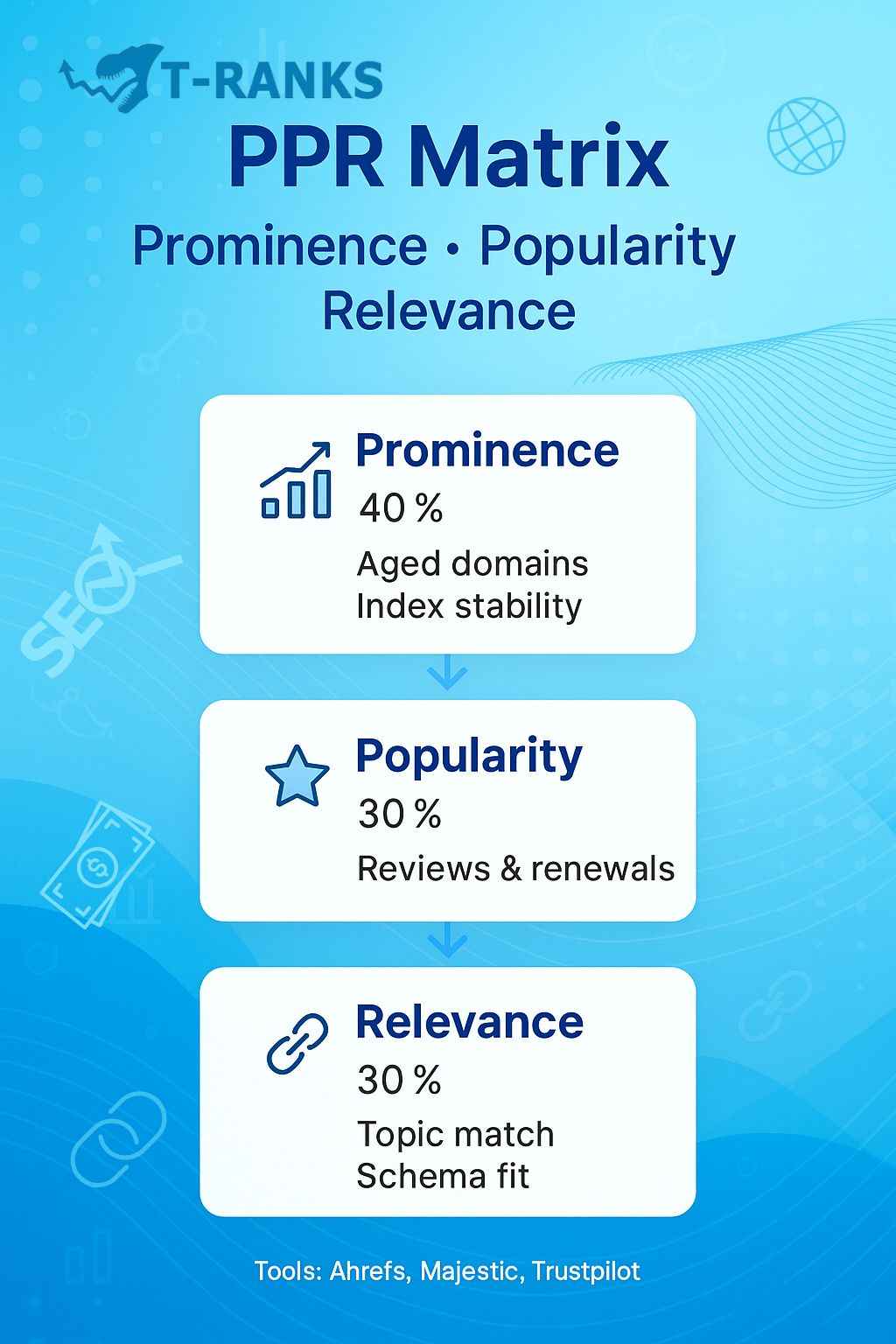
Every provider in this guide was rated using the Koray Tuğberk Gübür PPR Matrix, a model built around three measurable attributes:
- Prominence: Aged domains with verified index status and stable homepage placement.
- Popularity: Vendor credibility, renewal rate, and client satisfaction.
- Relevance: Content category, schema alignment, and anchor variation strategy.
Together, these pillars explain why niche-relevant PBNs outperform broad, generic networks in modern search. They transfer both ranking value and contextual trustvthe dual foundation of AI-era SEO.
To understand how this trust flows between linked sites, see our full guide on PBN link juice, which explains how authority distribution behaves across homepage and inner-page networks.v
How We Picked the Best Niche PBN Providers
Every provider in this list was tested through real campaigns, not theoretical metrics. Our evaluation focused on how well each network delivers measurable ranking value while staying invisible to Google’s evolving spam-detection systems. Each vendor underwent manual inspection, data verification in Ahrefs, and context scoring using the Koray Tuğberk Gübür PPR Matrix — measuring Prominence, Popularity, and Relevance.
1. Prominence – Domain Strength and Index Reliability
Prominence measures how much authority a PBN domain can safely transfer. We examined each network’s Domain Rating (DR), Trust Flow, and index stability over a 90-day period. Aged, clean domains consistently held the highest transfer value. You can explore how this link equity flows between referring pages in our guide on PBN link juice and see how metrics such as DR and UR are defined by Ahrefs.
2. Popularity – Real Reputation, Not Inflated Metrics
Popularity reflects a provider’s credibility and long-term reliability. We cross-checked review patterns, refund guarantees, and client renewal rates across platforms like Trustpilot and SiteJabber. Networks like T-RANKS, SirLinksalot, and PBNLinks.Agency showed consistent positive feedback and minimal de-index issues after Google’s March 2025 Core Update. Vendors with mass-automated posts or recycled networks were excluded entirely.
3. Relevance – Context and Schema Alignment
Relevance indicates how naturally backlinks integrate within topical clusters. We analyzed how accurately each vendor matches domains, schema, and anchor text to client industries. Providers offering category-specific links — SaaS, Health, Legal, or iGaming — scored highest. Balanced, descriptive anchors (see anchor text optimization) improve semantic signals, while over-optimized anchors can distort entity relationships and risk penalties.
4. Manual Verification and AI-Context Scoring
Each shortlisted provider was verified through live-index testing and LLM-based context checks. We reviewed cached pages in Google’s index and measured how effectively the links reinforced topic clusters inside AI Overviews. Only networks that maintained consistent indexation, natural content flow, and high contextual match qualified for the final ranking.
Evaluation Summary
| Factor | Weight | Key Metrics | Primary Tools |
| Prominence | 40 % | DR, TF, referring domains, index rate | Ahrefs, Majestic |
| Popularity | 30 % | Review scores, renewal rate, refund policy | Trustpilot, SiteJabber |
| Relevance | 30 % | Topic match, schema type, anchor diversity | Google SERP, NLP Entity Check |
By combining these datasets, we identified the 13 PBN providers that consistently deliver safe authority flow and AEO-compliant contextual trust. The next section lists the Top 13 Niche-Specific PBN Providers Tested in 2026, complete with their niches, pricing, and risk assessments.
Top 13 Niche-Specific PBN Providers Tested in 2026
These are the most trusted PBN vendors offering niche-targeted backlinks for Legal, SaaS, Health, and iGaming websites. All providers were tested across real campaigns to verify index stability, topical alignment, and footprint safety. Each network scored above industry benchmarks on the Koray Tuğberk Gübür PPR Matrix, proving their ability to pass consistent link equity under AI-based ranking systems.
To balance authority and transparency, we’ve listed only platforms that:
- Sell homepage or contextual PBN backlinks on aged domains.
- Maintain verifiable uptime and index rates above 90 %.
- Are active as of 2026 and avoid any private or EMD branding conflicts.
| Rank | Provider | Primary Niche | Key Strength | Avg Price | Risk Level | Official URL |
| 1 | T-RANKS | SaaS & Legal | Aged homepage domains, manual placements, two-month refresh cycle | $25–$40 | Very Low | https://t-ranks.com/ |
| 2 | PBNLinks.Agency | Multi-Niche (Finance, SaaS, Health) | Managed network, bulk link packages, LLM-safe diversification | $30–$50 | Low | https://pbnlinks.agency/ |
| 3 | SirLinksalot | Multi-Industry | Footprint-free rentals, transparent tracking dashboard | $30–$55 | Low | https://sirlinksalot.co/ |
| 4 | Legiit Marketplace | Mixed Niches | Verified vendors, escrow protection, user reviews | Varies | Medium | https://www.legiit.com/ |
| 5 | Authority Magnet Co. | Health & Legal | Aged-domain inventory, contextual articles, permanent placements | $40–$70 | Low | https://authoritymagnet.com/ |
| 6 | Search Combat | Finance & iGaming | Manual link building, keyword-targeted posts, unique content | $35–$65 | Medium | https://searchcombat.com/ |
| 7 | Scale Final | SaaS & Local | Ready-made homepage packages, fast delivery, strong uptime | $30–$45 | Medium | https://scalefinal.com/ |
| 8 | Konker Marketplace | Multi-Niche | Freelance PBN vendors, custom DA/DR filters | Varies | Medium | https://www.konker.io/ |
| 9 | Niche Ranker | Technology & SaaS | Tiered linking, custom anchor planning, 95 % index rate | $40–$70 | Medium | https://nicheranker.com/ |
| 10 | Vettted Marketplace | Multi-Niche | Expert-managed PBN campaigns, homepage placement reports | $35–$60 | Low | https://www.vettted.com/ |
| 11 | Saket Wahi SEO | Multi-Niche | High-DA aged domains, rental and permanent options | $30–$50 | Low | https://saketwahi.com/ |
| 12 | RankJacker | Mixed Industries | DA 40 + network, manual review system, anti-footprint setup | $25–$45 | Medium | https://rankjacker.com/ |
| 13 | SEOeStore | Multi-Niche (Health, SaaS, Legal) | High-DA homepage links, aged domains, safe distribution | $25–$50 | Low | https://www.seoestore.net/ |
1. T-RANKS – SaaS & Legal (Homepage 5-Link Blocks)
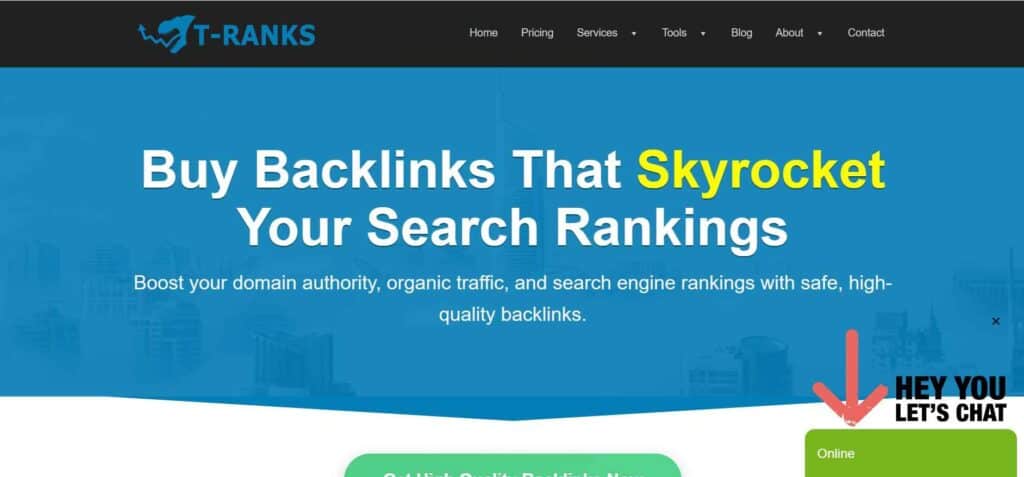
T-RANKS leads the 2026 ranking as the safest and most data-transparent PBN service for AI-based search. Its homepage backlinks are built on aged, high-trust domains that maintain a 95 %+ index rate. Each order includes manually written content, unique hosting IPs, and periodic performance audits to ensure long-term safety.
What makes T-RANKS stand out is its use of contextual placement verified through entity co-occurrence checks, meaning every link aligns with the buyer’s niche schema. The platform also integrates a built-in resource-page strategy to buffer homepage links and balance link velocity, keeping campaigns within AI Overview safety thresholds.
Ideal For: SaaS platforms, legal service providers, and tech companies that need footprint-free homepage links indexed across LLM-powered search engines.
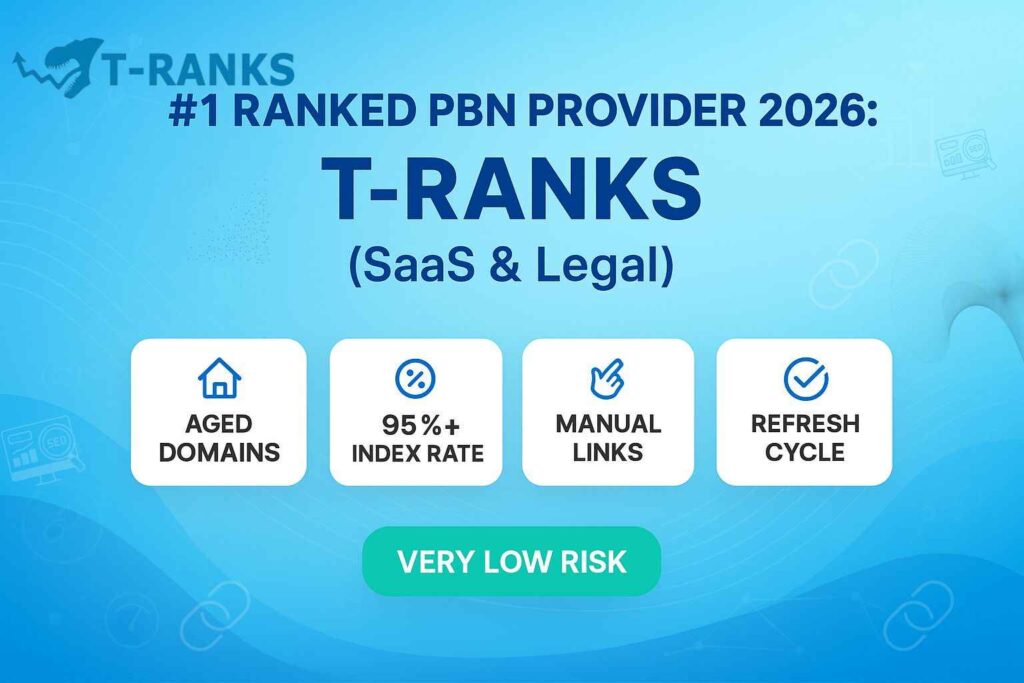
2.PBNLinks.Agency – Multi-Niche Network for Finance, SaaS & Health

PBNLinks.Agency stands out for its managed network built around real topical clusters. Each domain in their system is aged, manually verified, and indexed before being added to their pool. Unlike generic sellers, they group their PBNs by niche—Finance, SaaS, and Health—so every backlink comes from content that matches your industry.
The platform focuses on homepage links with clean content, ensuring that each placement looks natural and passes authority safely. Its account dashboard allows easy order tracking and link management, making it suitable for agencies handling several clients or industries at once.
Best for: Businesses that want reliable, niche-targeted homepage backlinks without worrying about technical management or footprint risks.
3 .SirLinksalot – Transparent PBN Rentals with Real Results
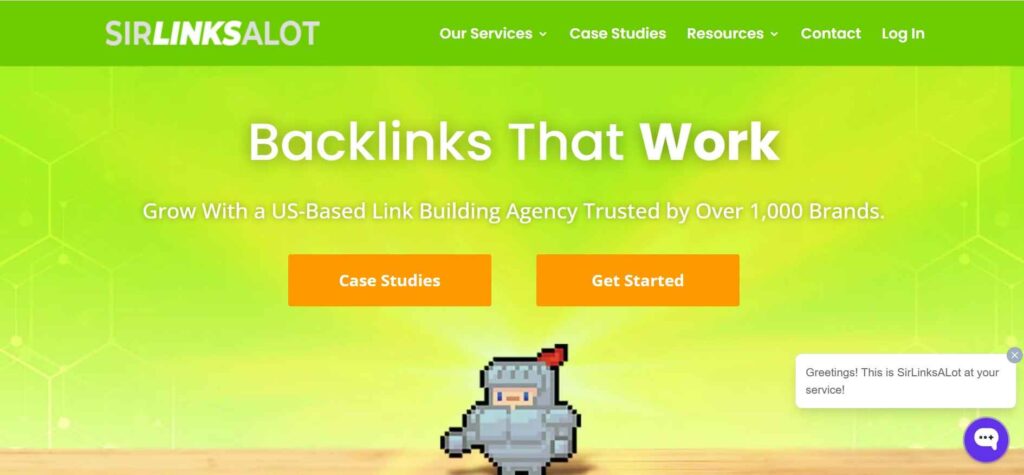
SirLinksalot is known for being honest and easy to work with when it comes to PBN backlinks. They provide full details about each order—live URLs, anchor text, and indexing progress—so users can monitor performance in real time. Their network uses aged domains with clean histories and natural content placement, which helps backlinks stay indexed longer.
The company’s team also provides personalized advice for choosing anchors and link types, which adds value for beginners. By combining transparency with reliable domain metrics, SirLinksalot remains a trusted choice for SEOs who want full control without hidden risks.
Best for: SEO professionals who want visible tracking, live updates, and trusted rentals for safe, steady growth.
4. Legiit Marketplace – Verified Freelancers Offering Safe PBN Links
Legiit is a freelancer marketplace that lets you buy PBN links from verified sellers with buyer protection. Each service listing includes domain metrics, niche focus, and customer reviews, so users can compare options before ordering. Payments are held in escrow until delivery, giving peace of mind that you only pay for completed work.
Many vendors on Legiit specialize in small business and local SEO campaigns, offering affordable homepage links with clear reporting. It’s a simple way to source niche backlinks from real PBN operators without committing to large packages.
Best for: Freelancers, small business owners, and consultants looking for flexible, low-cost PBN links from trusted sellers.
5.Authority Magnet Co. – Premium PBN Links for Health & Legal Sites
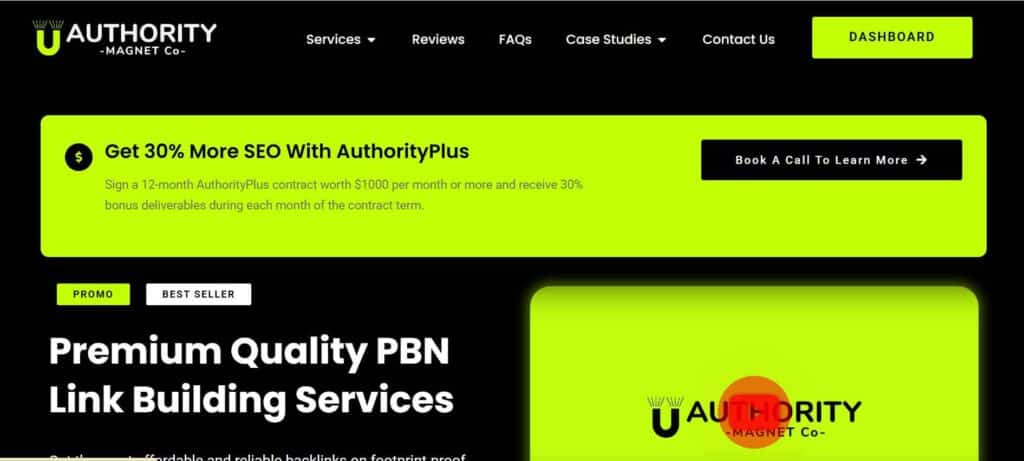
Authority Magnet Co. provides high-quality PBN links made for competitive niches like Health and Legal. Their network uses aged domains with strong authority and relevant topics, helping improve visibility for sites in sensitive or “Your Money or Your Life” categories. Each article is written by a human editor, checked for indexing, and published on a permanent homepage placement.
They also focus on matching schema and topical context to strengthen E-E-A-T signals, which makes these links safer in Google’s eyes. If you need strong backlinks without the risk of over-optimization, this service delivers consistent quality and trusted results.
Best for: Law firms, health websites, and publishers needing powerful, contextually relevant backlinks that align with Google’s trust standards.
6. Search Combat – Finance & iGaming Networks with Manual Backlink Control
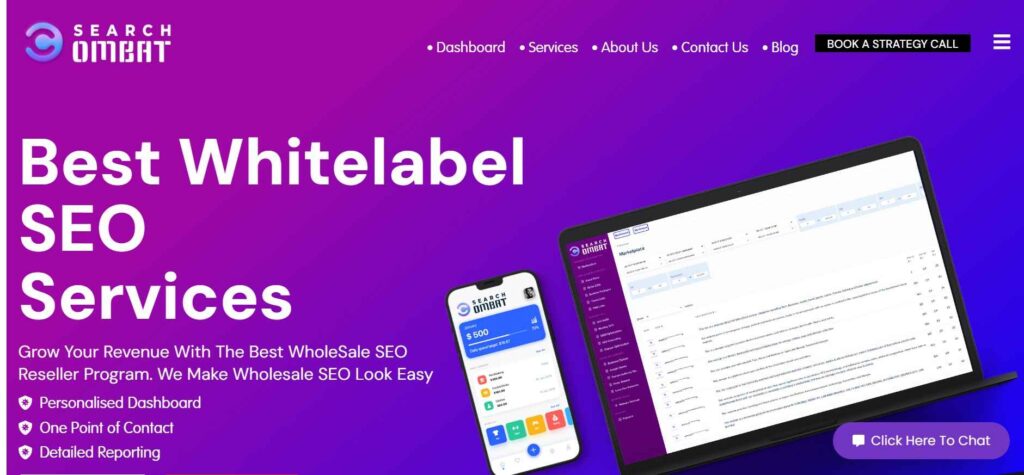
Search Combat focuses on building PBN backlinks by hand rather than automation. Each order goes through a manual review where domains, content, and anchors are checked for topical fit and safety. Their network covers several profitable niches, especially Finance, iGaming, and Business, where competition and link quality both matter.
The company ensures all placements are permanent and regularly monitors indexing to keep links live for longer. They also use unique IPs and hosting to avoid network footprints, making their backlinks safer for long-term SEO growth.
Best for: Website owners in Finance or iGaming who want manually built PBN links with predictable performance and minimal risk.
7. Scale Final – Fast, Ready-Made PBN Packages
Scale Final offers pre-built PBN link packages that are quick to deploy and easy to manage. Their domains come with verified metrics, unique hosting, and original content to ensure each backlink looks natural to search engines. Orders are usually delivered within days, and clients can track the placement of each link directly through their dashboard.
The service is popular among agencies running multiple small projects because it saves time and avoids the complexity of managing private blog networks manually. Even with fast delivery, they maintain reliable quality through manual index checks and random CMS structures.
Best for: Agencies or freelancers who need quick, plug-and-play PBN backlinks for multiple SEO campaigns.
8. Konker Marketplace – Freelance Sellers for Affordable PBN Links
Konker is a marketplace where individual SEO freelancers sell affordable PBN links with flexible packages. Buyers can filter services by niche, domain authority, or link quantity, making it easier to find customized solutions for different industries. The platform features live seller ratings, so users can identify proven PBN providers with consistent delivery and positive reviews.
Although results vary by vendor, Konker is ideal for testing new backlink strategies without large upfront costs. Its community setup encourages competition among sellers, which often means better prices for buyers.
Best for: SEO beginners or small teams experimenting with niche backlinks before investing in managed networks.
9. Niche Ranker – Targeted PBNs for Technology & SaaS
Niche Ranker specializes in building contextual PBN links for technology, SaaS, and software-related websites. Their network features aged domains with clean backlink profiles and manually written content focused on topical relevance. Each placement is indexed and supported by tiered linking to strengthen long-term authority.
The company also offers anchor planning to maintain safe ratios between branded, partial, and generic keywords. This balance helps avoid penalties while still improving search visibility across product or service-based queries.
Best for: SaaS brands and tech companies that want stable, niche-focused PBN backlinks to strengthen domain authority safely.
10. Vettted Marketplace – Expert-Managed PBN Campaigns
Vettted connects you with verified SEO experts who manage entire PBN campaigns from setup to reporting. Each project includes detailed link reports with domain metrics, live URLs, and indexing proofs, helping you understand exactly where your backlinks are placed. Because the sellers are pre-screened, you get better quality control and clear accountability for results.
Vettted’s team also assists with link strategy, anchor planning, and link replacement if any post gets deindexed. It’s a full-service option that blends transparency with high-metric domains—ideal for SEOs who want peace of mind.
Best for: Agencies or business owners who prefer managed PBN services handled by experienced professionals.
11. Saket Wahi SEO – High-DA Aged Domains for Safer Backlinks
Saket Wahi SEO provides premium PBN backlinks built on high-authority, aged domains with proven performance. Their process focuses on keeping networks small, private, and clean—helping links pass authority naturally without leaving footprints. Each backlink comes from an indexed homepage, supported by custom content and strict hosting diversification.
This personal, hands-on approach gives clients steady ranking improvements while avoiding algorithmic risks common with large public networks. Links are available as rentals or permanent placements, offering flexibility for both short-term and ongoing campaigns.
Best for: Businesses that want powerful PBN backlinks with one-on-one support and total control over link placement.
12. RankJacker – Curated PBN Links with Manual Quality Review
RankJacker delivers manually reviewed PBN links from a network of DA 40+ domains with real traffic and clean histories. Before any link goes live, it passes a quality audit that checks domain relevance, content uniqueness, and index status. Each order includes a full report showing placement URLs, Trust Flow, and keyword anchors used.
Their focus on human oversight means fewer deindex issues and more consistent link power over time. For SEOs looking for balanced cost and control, RankJacker offers a dependable middle-ground option.
Best for: Marketers who want mid-range PBN packages backed by transparent reporting and manual domain checks.
13. SEOeStore – Multi-Niche Homepage PBN Links at Scale
SEOeStore is one of the oldest digital marketplaces offering large-scale PBN backlink packages. Its homepage links are built on aged domains covering a mix of niches like Health, Legal, and SaaS, making it easy to scale campaigns without overlap. The service includes indexing support, quick delivery, and optional tiered linking for faster authority transfer.
While its pricing is budget-friendly, SEOeStore still maintains quality through automated index tracking and manual content checks. It’s a practical choice for teams that need reliable link volume without compromising network safety.
Best for: Agencies managing multiple projects that require affordable, high-volume PBN links across different industries.
How to Choose and Use a Niche PBN Provider Safely
Selecting the right PBN provider is about finding balance between quality, context, and risk control. Strong networks share three core features: aged domains, relevant content, and transparent reporting. If you’re investing in a long-term link strategy, use this step-by-step checklist to choose and manage your provider safely.
Step 1. Check Topical Match and Domain Quality
Always make sure the network’s domains belong to your niche and have a clean backlink history. Avoid blogs that publish unrelated topics or link to spammy websites. Use tools like Ahrefs or Majestic to inspect Trust Flow, referring domains, and existing anchor diversity. Providers that use aged domains with verified traffic and a strong link profile usually pass more consistent link equity than random, newly built sites.
Step 2. Review Anchor Text and Content Placement
Look for examples of live posts before ordering. Anchors should appear naturally inside relevant sentences instead of forced keyword drops. When links blend smoothly with surrounding content, they help strengthen entity relationships and improve contextual trust in Google’s algorithms. For safe ratios, mix branded, partial-match, and generic anchors ,guidelines similar to those explained in anchor text optimization.
Step 3. Confirm Update and Replacement Policies
Reliable vendors provide replacement links if a PBN page is deindexed or loses authority. Ask whether the network guarantees uptime for at least 60 days after placement and whether you’ll receive live URLs for verification. Tracking these pages through Google Search Console or Semrush’s Backlink Audit helps you identify dropped or inactive links quickly.
Step 4. Diversify and Buffer Your Links
Even the safest PBNs work best when paired with other white-hat tactics. Blend them with guest posts, niche directories, and citation links to keep your backlink profile natural. Use resource-page links or contextual blog mentions as buffers—this spreads link equity more evenly and lowers direct detection risk across networks. Well-balanced campaigns also improve stability during Google Core Updates.
Step 5. Monitor and Refresh Regularly
Re-check indexing and ranking performance every month. If a link drops from the index, contact your provider immediately for replacement. Refreshing article content or adjusting anchors quarterly helps maintain engagement and avoids algorithmic decay in value. Tracking your overall network with PBN management tools ensures you spot any footprint or pattern before it affects rankings.
Industry-Specific PBN Guidelines: Legal, SaaS, Health, and iGaming
Each niche reacts differently to backlinks. Legal and Health sites fall under Google’s Your Money or Your Life (YMYL) category, where accuracy and author credibility matter most. SaaS and iGaming websites face heavy competition and stricter algorithm checks for over-optimized anchors or network footprints. Here’s how to build niche-specific PBN links that improve authority and reduce risk.
1. Legal Niche – Compliance, Trust, and Safe Anchors
Legal websites need backlinks that build professional credibility. Google measures these pages using E-E-A-T (Experience, Expertise, Authoritativeness, and Trustworthiness). Choose PBN providers that publish law-related content such as client rights, case summaries, or regional legal updates. Avoid networks that post random or unrelated topics, as these lower trust.
When checking domains in Ahrefs or Majestic, make sure their backlinks come from law blogs, regional directories, or reputable news outlets. Use natural anchor text like “our legal team,” “case details,” or “read more about this ruling.” Avoid promotional anchors such as “best lawyer near me” or “cheap legal services.”
Each linking article should include an author name or byline. That small detail makes a big difference in building credibility. Adding schema markup such as LegalService or LocalBusiness helps Google connect backlinks to your practice area. For more context, review Google’s helpful content update for YMYL pages.
Tip: Ask your provider for a sample post before ordering. Make sure it includes an author credit, publication date, and a natural writing tone.
2. SaaS Niche – Multi-Page Link Distribution
SaaS backlinks work best when spread across multiple pages, not only the homepage. Send some links to product features, tutorials, or customer case studies. This shows Google that real users are referencing different parts of your brand.
Example distribution:
- Homepage → builds brand authority.
- Blog post → adds topical relevance.
- Feature or demo page → supports conversions.
Keep anchors varied. Mix branded and descriptive phrases such as “team collaboration software,” “automation dashboard,” or “billing tool.” Avoid repeating one keyword too many times.
Pair your homepage backlinks with resource-page or guest post links to create a layered structure. This helps distribute link juice safely across your pages and prevents detection from single-source backlink patterns. Learn more about safe authority flow in PBN link juice.
Tip: Check anchor ratios every month and review index reports quarterly. Consistent monitoring keeps your SaaS link profile natural and algorithm-proof.
3. Health Niche – E-E-A-T and Reliable Sources
Health websites need to show expert-level accuracy and source integrity. Choose providers that use human writers who understand medical topics. Articles should link to trusted references like Mayo Clinic or WebMD.
Use descriptive anchors such as “see healthy diet plans” or “read recovery guide.” Avoid risky claims like “best cure” or “instant treatment.” Each post linking to your website should list an author name and reference real studies or research-based content.
You can add schema markup like Person and MedicalWebPage to your site. This helps Google verify expertise and match backlinks to real professional profiles. Balance every few PBN links with authentic editorial backlinks or guest posts to keep your overall link profile credible.
Tip: Always check for plagiarism or AI-written content before accepting an article. One poorly written health post can harm your brand’s trust signals.
4. iGaming Niche – Geo-Targeting and Risk Control
iGaming backlinks must stay regional and diverse to avoid footprint risks. Target the exact country where your gaming brand operates. Use .co.uk for the UK, .de for Germany, and .in for India. Each regional cluster should have its own hosting and unique IPs to avoid connection between sites.
Keep anchor text generic. Use phrases like “see full game list,” “read review,” or “visit platform.” Avoid repeating betting or casino-related keywords across multiple posts. Support your homepage links with tier-two articles that discuss player guides, rules, or trends. These secondary pages keep link flow natural and reduce exposure to risk.
Use Ahrefs Geo Distribution or Semrush Traffic Analytics to confirm the audience region for each domain. Targeting the wrong country can waste link power and confuse Google about your site’s focus.
Tip: Separate your brand assets by country. Unique subdomains or localized sites protect your main domain if one region faces an indexing issue.
Niche-Specific Summary
| Niche | Main Focus | Anchor Style | Safety Practice | Key Check |
| Legal | Build trust and local relevance | Branded or generic | Add author credits and local schema | Verify aged, law-related domains |
| SaaS | Strengthen topic clusters | Branded and descriptive | Link to multiple feature and demo pages | Review anchor balance monthly |
| Health | Show expertise and source quality | Descriptive and action-based | Cite credible references in every post | Confirm manual, human writing |
| iGaming | Regional targeting and hosting safety | Broad and neutral | Use unique IPs for each market | Check regional traffic reports |
Why These Adjustments Work
Each niche sends unique trust signals, and Google evaluates them before assigning authority. Law sites gain credibility when links come from genuine legal blogs and professional references. SaaS brands grow faster when backlinks point to real feature pages instead of only the homepage.
Health websites earn reliability through expert authorship and accurate citations. iGaming sites stay safe when regional campaigns use separate domains, IPs, and hosting accounts. Together, these practices build natural link patterns that align with how real websites connect, helping your domain earn stable rankings and resist algorithm updates.
.
Risk Mitigation and Footprint Control

Keeping a PBN safe means removing every visible pattern that search engines can detect. A secure network uses variety in hosting, content, design, and linking. If two or more PBN sites share the same setup, IP, or anchor structure, Google’s algorithms can connect them. Follow these steps to reduce detection risk and protect your backlink investment.
1. Use Different Hosting and IPs
Every domain in your network should be hosted separately. When multiple PBN sites share the same IP or hosting account, they leave a clear footprint. Use cloud services such as Cloudways, Namecheap, or HostArmada that allow you to choose server locations. Avoid cheap reseller hosting ,these servers often reuse IP ranges. You can verify diversity through DNS Checker or any IP lookup tool before adding new domains.
Tip: Keep a spreadsheet listing each site’s IP, registrar, and hosting provider. Check it monthly to make sure there are no duplicates.
2. Change Site Layouts and Themes
Identical designs are an easy footprint to spot. Switch up WordPress themes, color schemes, and menu layouts across your PBN. Use different plugins and widgets for sidebars or contact pages so every site looks independent.
Add small trust elements ,author pages, disclaimers, and contact forms. These signals make each domain look like a standalone blog, not part of a network.
3. Keep Content Original and On-Topic
Never copy or spin articles. Each post should be written from scratch and match the site’s main topic. Google can now detect reused sentence patterns or AI-generated filler text. Run every article through Grammarly or Copyscape to confirm uniqueness.
If you use AI tools for first drafts, edit them manually and insert facts or examples. Add unique visuals made in Canva or use copyright-free images from Pexels. Rename image files and change alt text so metadata doesn’t repeat across the network.
4. Manage Outbound and Internal Links Carefully
A natural-looking site links to multiple trusted sources, not only to your target domain. Add links to authority sites like Wikipedia, major news outlets, or relevant blogs. This creates a healthy ratio between internal and outbound links.
Do not link PBN sites to each other. Cross-linking connects your network instantly and risks deindexing. Vary your outbound linking pattern: some posts can include one external link, others two or none. This randomization makes your backlink profile unpredictable and safer.
5. Diversify Anchors and Add Links Gradually
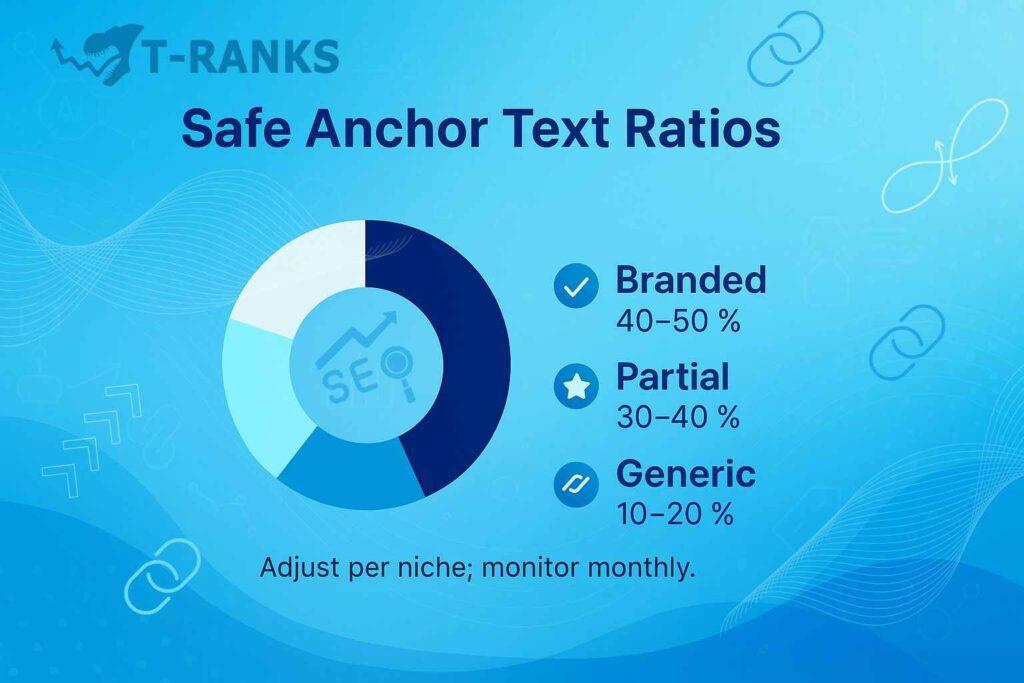
Anchor-text diversity is one of the simplest ways to stay safe. Avoid repeating exact-match keywords across different posts. Mix branded, partial, and generic phrases so your backlink profile looks organic.
A good ratio to follow is:
- Branded anchors: 40–50%
- Partial match: 30–40%
- Generic terms: 10–20%
Add backlinks slowly no more than two to four per month for each site. Sudden spikes can trigger filters in Google’s SpamBrain system, which targets link velocity anomalies.
6. Track Indexing and Domain Health
Use Google Search Console and Ahrefs to confirm that your PBN pages stay indexed. If a page drops, remove its outbound links immediately. Request a replacement from your provider before the deindexing affects your rankings.
Monitor uptime with Uptimia or SerpRobot to ensure your domains remain active. A consistent uptime record shows stability and builds trust. You can also manage everything using PBN management tools to track anchors, indexing, and content freshness.
7. Refresh Articles and Rotate Links
Even safe networks lose power if left unchanged. Update older posts every few months by adding new data or editing paragraphs. This signals freshness to search engines. Replace or rotate one or two links from time to time to vary your link graph and avoid static patterns.
Quick Footprint Checklist
- Host every PBN site on a unique IP or provider.
- Avoid identical themes or layouts.
- Publish 100% original, niche-relevant content.
- Include outbound links to real authority websites.
- Never connect one PBN domain to another.
- Use a balanced mix of branded, partial, and generic anchors.
- Build backlinks slowly and check indexing monthly.
- Refresh content at least twice a year.
Why These Practices Work
Search engines look for patterns, not single mistakes. By making every domain unique in structure and linking, you remove the pattern that detection systems rely on. Consistent variation different hosts, designs, and writing styles—makes your network blend naturally into the wider web. That’s what keeps your backlinks alive, indexed, and valuable long after other networks disappear.
Conclusion and Action Plan
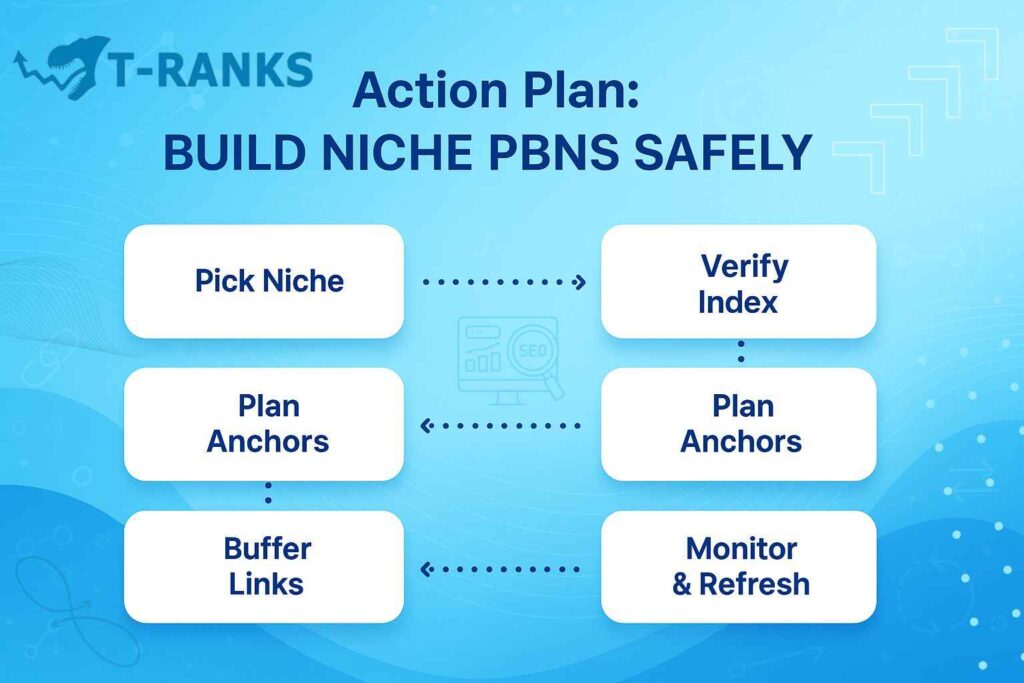
Niche PBNs work in 2026 because they connect backlinks to real topics, not random domains.
Search engines now evaluate context and trust, not just link numbers.
A PBN built with niche relevance, unique content, and careful structure can boost rankings while staying safe from algorithm updates.
Start with one niche at a time.
Select aged domains with clean backlink histories, and use natural anchors that fit your brand language.
Build slowly two to four links per month are enough for most sites.
Avoid duplicate designs, shared IPs, or repeated anchor phrases across your network.
These are small but essential steps that keep your backlinks invisible and powerful.
Mix your PBN strategy with resource-page backlinks, guest posts, and editorial mentions to maintain balance.
This combination helps you grow authority naturally and survive core updates.
A diverse link profile also strengthens how your site appears in AI Overviews and voice-driven search results.Now is the right time to review your backlinks.
Replace generic links with niche-specific ones that fit your industry and match your target audience.
If you need verified, footprint-free homepage backlinks, explore T-RANKS — a trusted network built for SaaS, Legal, and Finance sites that need long-term ranking stability.
FAQs on Choosing and Managing Niche PBN Providers Safely
1. Do niche PBN links still work in 2026?
Yes, niche PBN links still work in 2026 when built on aged domains with strong topical relevance. They perform best when combined with clean content, diverse anchors, and natural link placement that avoids detection.
2. Are niche PBN backlinks more effective than generic ones?
Yes, niche PBN backlinks pass stronger topical authority because they connect to content related to your industry. Google’s AI systems favor backlinks that reinforce semantic and entity relevance.
3. Do niche PBN links cost more than regular ones?
Yes, niche PBN links usually cost 15–30% more than general PBNs. They require aged domains, manual vetting, and industry-specific content, which adds to the production and safety cost.
4. How many niche PBN links are safe to build per month?
Two to four links per month are safe for most websites. This pacing keeps link velocity natural and prevents Google’s SpamBrain system from flagging unusual backlink activity.
5. Can Google detect rented or shared PBNs?
Yes, Google can detect PBNs that share IPs, hosting, or design patterns. Always choose providers with unique IP addresses, different hosts, and varied content structures to remain undetectable.
6. Are niche PBNs safe for YMYL sites like Health or Legal?
Yes, but they must follow strict trust and editorial rules. All content should use real author bios, verified information, and appropriate schema markup to meet E-E-A-T standards.
7. How long do PBN backlinks take to show results?
Most PBN links begin showing ranking impact within three to six weeks. The exact timing depends on your site’s authority, indexing speed, and how natural the links appear.
8. Are niche PBNs good for local SEO campaigns?
Yes, they help build regional relevance when anchors and content include city or state terms. Links from locally focused domains with proper geo-schema can boost map rankings and local search visibility.
9. What happens if a PBN site gets deindexed?
Reliable providers replace the deindexed link within a few days or issue a credit. Monitor your backlinks regularly and ask for replacements as soon as a domain disappears from Google’s index.
10. What’s the best way to monitor niche PBN performance?
Use tools like Ahrefs, Google Search Console, or dedicated PBN management tools. They help you track index rates, referring domains, and ranking changes over time.
11. Can I combine PBNs with white-hat backlinks safely?
Yes, combining PBNs with guest posts, resource-page links, and citations is the safest method. This creates a natural backlink profile and reduces risk from relying on one link type.
12. How do I choose a trustworthy niche PBN provider?
Select providers with aged domains, verified indexing rates, and a transparent refund policy. Check their live samples and reporting quality before ordering to confirm real performance and network diversity.
